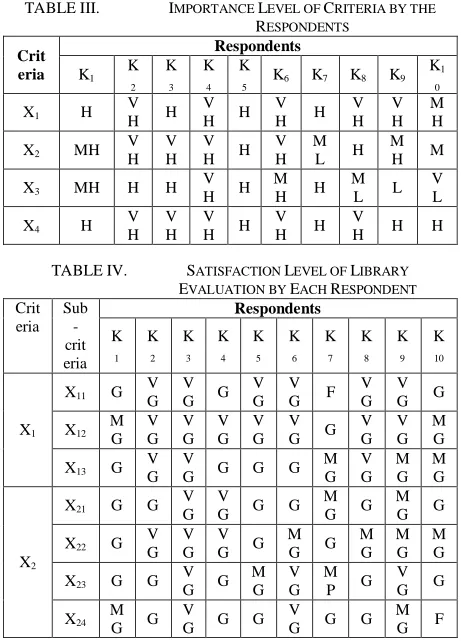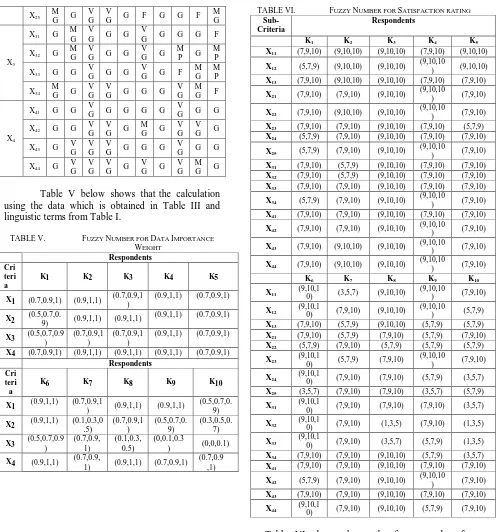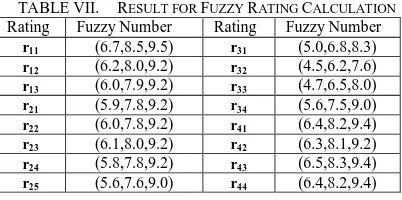ISBN 978-967-14020-0-9 ©BMCRC2016
36
EVALUATION OF LIBRARY SERVICES
USING FUZZY APPROACH
Ainun Hafizah Mohd, Syafiza Saila Binti Samsudin, Norhuda Mohammed, and Shafahani Binti Abu Seman @ Osman
Department of Mathematics, Faculty of Computer Sciences, Universiti Teknologi MARA (Pahang), 26400 Bandar Tun Abdul Razak Jengka, Pahang.
{ainunhafizah, syafi915, hudamohammed}@pahang.uitm.edu.my, [email protected]
Abstract—Library is one of the important departments in academic institutions that enable the exchange and growth of information, knowledge, and culture among lecturers, students, and the general public. The important thing about the library is quality services. Service quality of library consists of some attributes such as physical facilities and staff behaviors. Evaluation of quality services may help library management to ensure the improvement of services by
investigating students’ opinion towards library services. The objective of this research is to evaluate the quality of services provided by the library based on certain criteria using Fuzzy Multi-Criteria Decision Making (MCDM) evaluation method. A fuzzy logic method is used to deal with the decision in the ambiguous situation. A research was conducted at Perpustakaan Al Bukhari in Universiti Teknologi MARA (Pahang). A questionnaire has been used to collect the data. Respondents were students who came to the library four times a week. Result stated that the best criterion is staff service while the worst is the environment at the library.
Keywords-Library Services, Service Quality, F uzzy Multi-Criteria Decision Making, Linguistic terms.
I. INTRODUCTION
Academic institution usually attached with libraries which play a role to fulfill the teaching and research needs of students and staff [1]. According to [10] the objective for a library is to improve library service with fulfilling the user requirements. Based on [2], the goal for a library is to maintain the service quality and satisfy the users. There are a few criteria to evaluate service quality such as leadership, resources, physical facilities and staff behavior [12]. Service quality can be recognized by customer loyalty and their feedback about satisfaction based on [9]. In this research, library services isare evaluated by using fuzzy Multiple Criteria Decision Making (MCDM). The best evaluator for service quality in a library is the users that came to the library [4].
This research proposed fuzzy evaluation method in evaluating library service. Fuzzy logic is a useful method to deal with the decision in an ambiguous
situation [6]. According to [7] using fuzzy MCDM would avoid bias and minimize partiality. Based on [13], quality services must have a fuzzy linguistic technique to create a user-friendly framework. MCDM method must have a decision maker to judge the quality services for qualitative criteria rating and the weight of criteria. However, rating and weight in library services are difficult to characterize because of the existence of uncertainty, but it can be easily evaluated if a linguistic term is used. Linguistic quality rating is combining linguistic evaluation judgments from the customer on the different criteria [13]. Fuzzy decision making has been expanded from traditional MCDM method where linguistic term always been used to solve the fuzzy MCDM problem [15]. Linguistic terms enhance after modeled by fuzzy numbers, like triangular fuzzy number [8]. Thus, linguistic term is one of the solutions for MCDM method since it can compute the evaluation without specific number but in variables such as very low, low, medium low, medium until very high.
This study was conducted to evaluate the quality of services provided by library based on certain criteria using fuzzy evaluation method. This research uses MCDM to evaluate the quality services. The fuzzy evaluation is one of the methods to the ambiguous problem. Therefore, fuzzy MCDM is the best way to evaluate the service quality because it uses respondents. This research has been done at Perpustakaan Al-Bukhari UiTM Pahang. 93 respondents who were selected randomly answered this questionnaire which is more than 30 percent of the visitors for a week.
II. PRELIMINARIES
The basic definition of a fuzzy number and its operations on triangular fuzzy numbers are given as follows.
A. Fuzzy Number
37
membership function of a fuzzy number A can be defined as
other wise d x c f
c x b
b x a f
x f
R A L A
A
, 0
, , 1
,
(1)
where
f
AL:
[
a
,
b
]
[
0
,
1
],
f
AR:
[
c
,
d
]
[
0
,
1
],
L A
f
andf
ARare the left and right membership function of the fuzzy number A respectively. Trapezoidal fuzzy numbers are denoted as (a,b,c,d)and triangular fuzzy number which are special cases of trapezoidal fuzzy numbers with b= c are denoted as
(a,b,d).
B. Operations on Triangular Fuzzy Numbers
Let X and Y be two triangular fuzzy numbers parameterized by
(
x
1,
x
2,
x
3)
and(
y
1,
y
2,
y
3)
respectively. The fuzzy number arithmetic operations
X and Y are presented as follows: Addition operation:
)
,
,
(
x
1y
1x
2y
2x
3y
3Y
X
(2)Subtraction operation:
)
,
,
(
x
1y
3x
2y
2x
3y
1Y
X
(3)where
x
1,
x
2,
x
3,
y
1,
y
2andy
3are real numbers. Multiplication operation:)
,
,
(
x
1y
1x
2y
2x
3y
3Y
X
(4)Division operation:
)
/
,
/
,
/
(
/
Y
x
1y
3x
2y
2x
3y
1X
(5)where
x
1,
x
2,
x
3,
y
1,
y
2andy
3are real numbers. III. PROPOSED METHODQuestionnaires were given to 10 respondents who are the respondents that use the library services. It used two sets of fuzzy linguistic terms to evaluate the importance levels of each criterion and the satisfaction levels of each sub-criterion. The linguistic terms can be expressed as trapezoidal fuzzy numbers as in Table I and Table II.
LINGUISTIC TERMS FOR IMPORTANCE WEIGHTS [3] TABLE I.
Linguistic terms Fuzzy Numbers
Very Low (0,0,0.1)
Low (0,0.1,0.3)
Medium Low (0.1,0.3,0.5)
Medium (0.3,0.5,0.7)
Medium High (0.5,0.7,0.9)
High (0.7,0.9,1)
Very High (0.9,1,1)
LINGUISTIC TERMS FOR SATISFACTION
TABLE II.
RATING [3]
Linguistic terms Fuzzy numbers
Very Poor (0,0,1)
Poor (0,1,3)
Medium Poor (1,3,5)
Fair (3,5,7)
Medium Good (5,7,9)
Good (7,9,10)
Very Good (9,10,10)
The procedure of the fuzzy evaluation can be explained into several steps. Procedures for Step 1 until Step 6 were based on [11]. The procedure is:
Step 1:
For Krespondents, the fuzzy weight
w
i, of each criterion, i is calculated using aggregated fuzzy assessment which is defined asK
w
w
K k
k i i
1(6)
where
w
ik is the importance weight of the k-th decision maker. The fuzzy weighted vector criteriacan be represented
W
w
1w
2
w
i
T.Step 2:
The fuzzy rating
r
ij, of each alternative is calculated using aggregated fuzzy assessment which is defined asK
x
r
K k
k ij ij
1(7)
where x is the satisfaction rating of the ijk k-th
decision maker for i-th criterion and j-th sub-criterion.
Step 3:
The fuzzy grade gij, of each criterion is calculated
using aggregated fuzzy assessment which is defined as
j r g
n j m i
j i
k ij ij
, 1 , 1
(8)
where criterion,i is i=1, 2,...,m and sub-criterion, j
is j = 1, 2,...,n.
Step 4:
38
denotes the number of criteria.
Step 5:
The total fuzzy grade vector R is calculated as
function ofR
i respectively.This proposed method is implemented to the evaluation of library services as shown by the hierarchical structure in Figure 1. The evaluation criteria are taken from [11] and [5].
IV. FUZZY EVALUATION OF LIBRARY SERVICES The evaluation was done through a questionnaire that contains 16 criteria regarding the library services. The questionnaires were divided into four parts which are the environment of the library, information about the library, internet access, and staff services. The required data were gathered in the form of a questionnaire asking the respondents to choose the importance of the mentioned indicators based on linguistic terms taken from [3]. The
hierarchical structure of service evaluation is shown in Figure 1.
Fig. 1: The hierarchical structure of the service
Two sets of fuzzy linguistic terms used to evaluate the importance levels of each criterion and the satisfaction levels of each sub-criterion are distributed to the respondents. The data analyzed by fuzzy evaluation method. For the written description, data represent only for 10 respondents. Table III shows the importance weight, and Table IV shows the satisfaction ratings evaluate by respondents.
39 X25 M
G G V G
V
G G F G G F M G
X3
X31 G M G
V
G G G V
G G G G F
X32 G MG VG G G VG G MP G MP
X33 G G V
G G G V
G G F M G
M P
X34 M G G
V G
V
G G G G
V G
M G F
X4
X41 G G V
G G G G G V
G G G
X42 G G V G
V G G
M G G
V G
V G G
X43 G VG VG VG G G G VG G G
X44 G V G
V G
V G G
V G G
V G
M G G
Table V below shows that the calculation using the data which is obtained in Table III and linguistic terms from Table I.
FUZZY NUMBER FOR DATA IMPORTANCE
TABLE V.
WEIGHT
Respondents Cri
teri a
K1 K2 K3 K4 K5
X1 (0.7,0.9,1) (0.9,1,1) (0.7,0.9,1) (0.9,1,1) (0.7,0.9,1)
X2 (0.5,0.7,0.9) (0.9,1,1) (0.9,1,1) (0.9,1,1) (0.7,0.9,1)
X3 (0.5,0.7,0.9) (0.7,0.9,1) (0.7,0.9,1) (0.9,1,1) (0.7,0.9,1)
X4 (0.7,0.9,1) (0.9,1,1) (0.9,1,1) (0.9,1,1) (0.7,0.9,1) Respondents
Cri teri a
K6 K7 K8 K9 K10
X1 (0.9,1,1) (0.7,0.9,1) (0.9,1,1) (0.9,1,1) (0.5,0.7,0. 9)
X2 (0.9,1,1) (0.1,0.3,0.5) (0.7,0.9,1) (0.5,0.7,0.9) (0.3,0.5,0.7)
X3 (0.5,0.7,0.9) (0.7,0.9,1) (0.1,0.3,0.5) (0,0.1,0.3) (0,0,0.1)
X4 (0.9,1,1) (0.7,0.9,
1) (0.9,1,1) (0.7,0.9,1)
(0.7,0.9 ,1)
FUZZY NUMBER FOR SATISFACTION RATING
TABLE VI. Sub-Criteria
Respondents
K1 K2 K3 K4 K5
X11 (7,9,10) (9,10,10) (9,10,10) (7,9,10) (9,10,10)
X12 (5,7,9) (9,10,10) (9,10,10) (9,10,10) (9,10,10)
X13 (7,9,10) (9,10,10) (9,10,10) (7,9,10) (7,9,10)
X21 (7,9,10) (7,9,10) (9,10,10)
(9,10,10
) (7,9,10)
X22 (7,9,10) (9,10,10) (9,10,10) (9,10,10) (7,9,10)
X23 (7,9,10) (7,9,10) (9,10,10) (7,9,10) (5,7,9)
X24 (5,7,9) (7,9,10) (9,10,10) (7,9,10) (7,9,10)
X25 (5,7,9) (7,9,10) (9,10,10)
(9,10,10
) (7,9,10)
X31 (7,9,10) (5,7,9) (9,10,10) (7,9,10) (7,9,10)
X32 (7,9,10) (5,7,9) (9,10,10) (7,9,10) (7,9,10)
X33 (7,9,10) (7,9,10) (9,10,10) (7,9,10) (7,9,10)
X34 (5,7,9) (7,9,10) (9,10,10)
(9,10,10
) (7,9,10)
X41 (7,9,10) (7,9,10) (9,10,10) (7,9,10) (7,9,10)
X42 (7,9,10) (7,9,10) (9,10,10) (9,10,10) (7,9,10)
X43 (7,9,10) (9,10,10) (9,10,10)
(9,10,10
) (7,9,10)
X44 (7,9,10) (9,10,10) (9,10,10)
(9,10,10
) (7,9,10)
K6 K7 K8 K9 K10
X11
(9,10,1
0) (3,5,7) (9,10,10)
(9,10,10
) (7,9,10)
X12
(9,10,1
0) (7,9,10) (9,10,10)
(9,10,10
) (5,7,9)
X13 (7,9,10) (5,7,9) (9,10,10) (5,7,9) (5,7,9)
X21 (7,9,10) (5,7,9) (7,9,10) (5,7,9) (7,9,10)
X22 (5,7,9) (7,9,10) (5,7,9) (5,7,9) (5,7,9)
X23
(9,10,1
0) (5,7,9) (7,9,10)
(9,10,10
) (7,9,10)
X24
(9,10,1
0) (7,9,10) (7,9,10) (5,7,9) (3,5,7)
X25 (3,5,7) (7,9,10) (7,9,10) (3,5,7) (5,7,9)
X31
(9,10,1
0) (7,9,10) (7,9,10) (7,9,10) (3,5,7)
X32
(9,10,1
0) (7,9,10) (1,3,5) (7,9,10) (1,3,5)
X33
(9,10,1
0) (7,9,10) (3,5,7) (5,7,9) (1,3,5)
X34 (7,9,10) (7,9,10) (9,10,10) (5,7,9) (3,5,7)
X41 (7,9,10) (7,9,10) (9,10,10) (7,9,10) (7,9,10)
X42 (5,7,9) (7,9,10) (9,10,10)
(9,10,10
) (7,9,10)
X43 (7,9,10) (7,9,10) (9,10,10) (7,9,10) (7,9,10)
X44
(9,10,1
0) (7,9,10) (9,10,10) (5,7,9) (7,9,10)
40 RESULT FOR FUZZY RATING CALCULATION
TABLE VII.
Rating Fuzzy Number Rating Fuzzy Number
r11 (6.7,8.5,9.5) r31 (5.0,6.8,8.3) fuzzy grade matrix
G
and total fuzzy grade vector R, as follows:
for each criteria and sub-criteria shown in Table 5.
CENTROID POINT FOR CRITERIA AND SUB -TABLE VIII.
CRITERIA
Criteria Centroid value
Ranking Sub-criteria importance weight and satisfaction rating. For the main criteria, the best ranking is
X
4(Staff Service) followed by internet access, environment at thelibrary and information about library. The ranking result for the main criteria is
X
4
X
3
X
1
X
2.
While for the sub-criteria, the best ranking was obtained as follows:
13 the library homepage.
While for criteria 2, the best sub-criteria was that reliability references of services followed by informativeness of the library website, the correctness of e-catalogue, advising about library services and facilities and the last sub-criterion is the representation of relevant e-journals and database.
User friendliness of e-catalogue was the best for criteria 3. The suitability of open hours for internet access was chosen as the second and followed by the correctness of fulfilling requires for internet access and serving speed for internet access.
Staff willingness to help customers has become the best sub-criteria for criteria 4. Next is staff
competence, staff ability to answer customer’s
questions followed by staff friendliness.
Based on this research, a library should widely promote their informative systems that they already established. This will make it easier for the students to find needed materials and to accomplish their assignments and research work.
Library management should improve the environment at the library so that students will be able to study comfortably with complete facilities provided by the library. Hopefully, it will encourage students to revisit the library and used all the facilities needed for their learning process.
REFERENCES
[1] P., Adeniran, “User satisfaction with academic libraries services: Academic staff and students' perspectives”, International Journal of Library and Information Science, vol. 3(10), pp. 209–216, 2011. Academic Journal [Online]. Available at: http://www.academicjournals.org/ ijlis (Accessed: 10 April 2016).
[2] Y.T. Chen, and T. Y. Chou, “Applying GRA and Q F D to improve service quality”, The Journal of Academic Librarianship, vol. 37, pp. 237-245, 2011.
[3] S.Y.Chou, and Y.H. Chang, “A decision support system for supplier selection based on strategy aligned fuzzy SMART approach”, Expert Systems with Application, vol. 34, pp. 2241-2253, 2008.
41 identification and measurement of academic library
service constructs”, Dissertation Abstracts International, vol. 62, pp. 2295A, 2001.
[5] O. Einasto, “Using service quality monitoring to support library management decisions: A case study from Estonia”, The International Information & Library Review, vol.41, pp.12-20, 2009.
[6] R. Jamali, and H.S. Tooranloo, Prioritizing academic library service quality indicators using fuzzy approach”, Library Management, vol 30, pp. 319-333, 2009.
[7] J.W. Lee, and S.H. Kim, “Using analytic network process and goal programming for independent information system”, Computer and Operations Research, vol 27, pp. 367-382, 2000.
[8] G. Liang, “F u z z y MCDM based on ideal and anti-ideal concepts”, European Journal of Operational Research, vol 112, pp. 682-691, 1999.
[9] H.T. Lin, “Fuzzy application in service quality analysis: An empirical study”, Expert Systems with Applications vol 37, pp. 517-526, 2010.
[10] A.H., Mohd, S. Ahmad, and F. Shohaimay, “Library services evaluation using Analytical Hierarchy Process”, 2012.
[11] F. Shohaimay, N. Ramli, and S.R. Mohammed, “Fuzzy evaluation in IT supplier selection”, Proceedings of 2012 IEEE Symposium on Computer Applications and Industrial Electronics (ISCAIE 2012) Kota Kinabalu, Malaysia, pp. 43-47. 2012.
[12] H. Tohidi, and M. M. Jabbari, “Service quality evaluating models. Procedia Social and Behavioral Sciences”, vol 31, pp. 16-24, 2012.
[13] H.E. Viedma, E. Pies, J.M.M. Castillo, S. Alonso and K. Anaya, “A fuzzy linguistic model to evaluate the quality of web sites the store XML documents”, International Journal of Approximate Reasoning, vol 46, pp. 226-253, 2007.
[14 Y.T. Wang, J.B. Yang, D.L. Xu, and K.S. Chin, “ On the centroid of fuzzy numbers”, Fuzzy Sets and Systems vol 157, pp. 919-926, 2006.
![TABLE II. LINGUISTIC TERMS FOR SATISFACTION RATING [3]](https://thumb-ap.123doks.com/thumbv2/123dok/3503382.1772518/2.612.66.285.619.695/table-ii-linguistic-terms-satisfaction-rating.webp)


